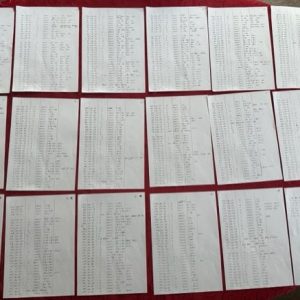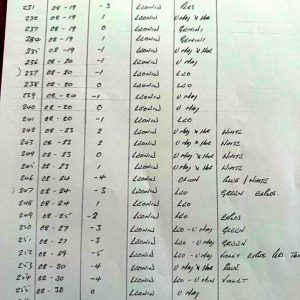The Night of the Fireballs
It was a cold, clear night in November and the clock was striking ten.
The stars shimmered with frosty brightness in a bible-black sky.
At 10.15pm the first extraterrestrial visitor appeared.
It had travelled millions of miles across the immense ethereal gulf of space.
Now it arrived in a trail of light that blazed down the valley.
It would be the first of many to invade our planet that night.
This is not the beginning of a science fiction novel.
It’s how the best observing night of my life began.
It was the Night of the Fireballs!
The Leonid Meteors
The Leonid meteor shower in mid-November has a spectacular history.
You can read about them in our recent blog.
Meteor Predictions
By studying the Leonids, astronomers refined their methods of predicting meteor activity.
The meteor shower would give an enhanced diplay in 1998.
In 1999, it could be a meteor storm, with over 1,000 shooting stars an hour.
You can read about my experience of the 1999 display in the previous blog.
It was 1998 that turned out to be unexpectedly spectacular.
Trial Run
At the time, I was Director of Star Centre at Sheffield Hallam University.
With colleagues Paul Crowder and Steve Ibbotson, we decided to observe both the ’98 and ’99 events.

The 3 amigos: Dennis, Steve & Paul in Portugal.
We needed a dark sky venue.
So we chose a camp site near Malham in North Yorkshire.
Malham Base Camp
Our three-man expedition set up camp near Malham Cove in North Yorkshire.

Leonid camp, Malham Cove, 1998. Photo: D. Ashton
We pitched our tents on a deserted camp site.
Camping in November is cold, freezing cold!

Malham camp, November 17 / 16, 1998.
Fortunately November 17th, 1998 was a glorious winter day.
As darkness fell, the temperature dropped.
We decided to walk three miles to the local hostelry for warmth.
There the locals felt sorry for us and shared their meals!
We returned, quite sober, and prepared for an all-night observation session.
The sky was perfectly clear. Stars twinkled in a coal black sky.
It was so different to the light polluted skies at home in Sheffield.
The First Fireball
We expected the first meteors around midnight.
Then the constellation Leo, radiant point of the shooting stars, would be above the horizon.
So it was a surprise when that first fireball blazed along the valley at 10.17pm.

Fireball 1 Credit:m DNA Web Team
It burned across the sky from the eastern horizon to overhead and then to the north.
We estimated the brightness at magnitude -4.
That’s about the same as Venus at its brightest.
It was the first fireball of the night.
The meteor seemed to shoot low over the valley because the Leo radiant was low in the east.
At the time, we likened it to a Scud missile.
Three more fireballs followed in the next 15 minutes.
In the next hour we saw 20 more bright Leonids.
All this before we expected to see any at all!
A Wonderful Night
Before midnight we saw 42 meteors.
They were bright, many between magnitude 0 and -2.
One exceptional purple/blue fireball lit the ground.
It left a green train, a trail of light that lasted for several minutes.
This was an amazing mag -6.

Fireball. Credit: NASA
Between midnight and 1am, we recorded 6o meteors.
That’s one a minute!
They were fast and showed a range of colours.
We recorded white, yellow, orange, red, green and blue shooting stars.
And so the celestial firework display went on.
Virtually all the shooting stars were brilliant.
That’s magnitude 1 and above, bright as the brightest winter stars.
1am to 2am: 93 meteors
2am to 3am: 203 meteors, peak rate
3am to 4am: 123 meteors
4am to 5am: 112 meteors
5am to 5.17 am: 20 meteors
In all, we recorded 653 meteors during the night.
Among these were over 30 fireballs.
These were meteors with magnitudes -4 and above.
Sometimes several meteors streaked across the sky aty the same time.
We couldn’t record all of them so in reality we saw more than the 653 we did record.
One of the brightest came at 00.50am.
It exploded in a flare of light that lit the landscape.
Nearby sheep woke up, startled by the flash.
The meteor left a blue train in the sky.

Fireball. Credit: NASA
In 10 minutes between 01.49 and 01.59 we saw seven fireballs blaze across the sky.
Most were green. All lit up the ground like floodlights.
In one minute at 02.19am we recorded 10 dazzling meteors, 3 fireballs.
Dawn
The final burst of fireballs came just before dawn.
Three purple meteors exploded overhead in a single minute.
When dawn came, the sky warmed to pale blue.

Daylight meteor: NASA
Even with the onset of daylight, we saw more bright shooting stars.
These we couldn’t record.
As the winter Sun warmed us, we reflected on the magical experience.
We are seasoned astronomers, we have seen wonderful sights in the sky.
But this night was the best of all.
The Night of the Fireballs is one we shall never forget.
Meteor Record
We recorded the meteors by speaking into a recording machine.
Writing on paper in the damp darkness is not easy.
Back home Paul transcribed our observations.
That transcript runs to 18 closely packed A4 pages!

Fireball night record. Paul Crowder

Each page records 25 meteors.
On this typical page, see how many meteors have a negative magnitude.
These are brighter than the brightest stars.
Those with magnitudes of -4 or more are fireballs.
Analysis
Meteor brightness
My first chart shows the numbers of meteors at each magnitude.
The charts haven’t downloaded too well but I hope they are worth looking at.

On the vertical scale, numbers go up from zero to 120 in increments of 20.
Negative values, very bright, are to the left of the chart.
The bigger the negative number, the brighter the meteor.
Most of the meteors we saw were brighter than almost all stars.
Many of them, -4 and more, were fireballs!
Those of magnitude -6 and more lit up the ground.
To see fireballs with magnitudes greater than -6 is rare.
Maybe we see one every few years.
We saw several in a few hours.
Meteor Frequency
Again apologies for the poor reproduction of the chart.

This time meteor numbers go from zero to 140 on the vertical axis.
The chart shows clearly how the number of observed meteors grew during the night.
Numbers peaked in the 5th hour, between 02.00 and 03.00am.
Then they came at 3 or more per minute.
Although meteor numbers then reduced, they were still coming at over 100 per hour until dawn.
Reflections
The Leonid meteors of November 17th / 18th, 1998 provided my best observing night ever.
It was an amazing experience to sit beneath a natural fireworks display.
My only regret is that we did not photograph the meteor display.
We didn’t have smartphones or digital cameras in those days.
But the images remain powerful in my memory.
And our record of that night is a rarity.
Very few people experienced the Night of the Fireballs.
I’m so glad that we did!

The author: Dennis Ashton is a Fellow of the Royal Astronomical Society and a Wonderdome presenter.
Would you like to hear more Astronomy news?
Do you want to to find out about our upcoming public events?
Follow WonderDome Portable Planetarium on Twitter and Facebook or go to our web site wonderdome.co.uk

